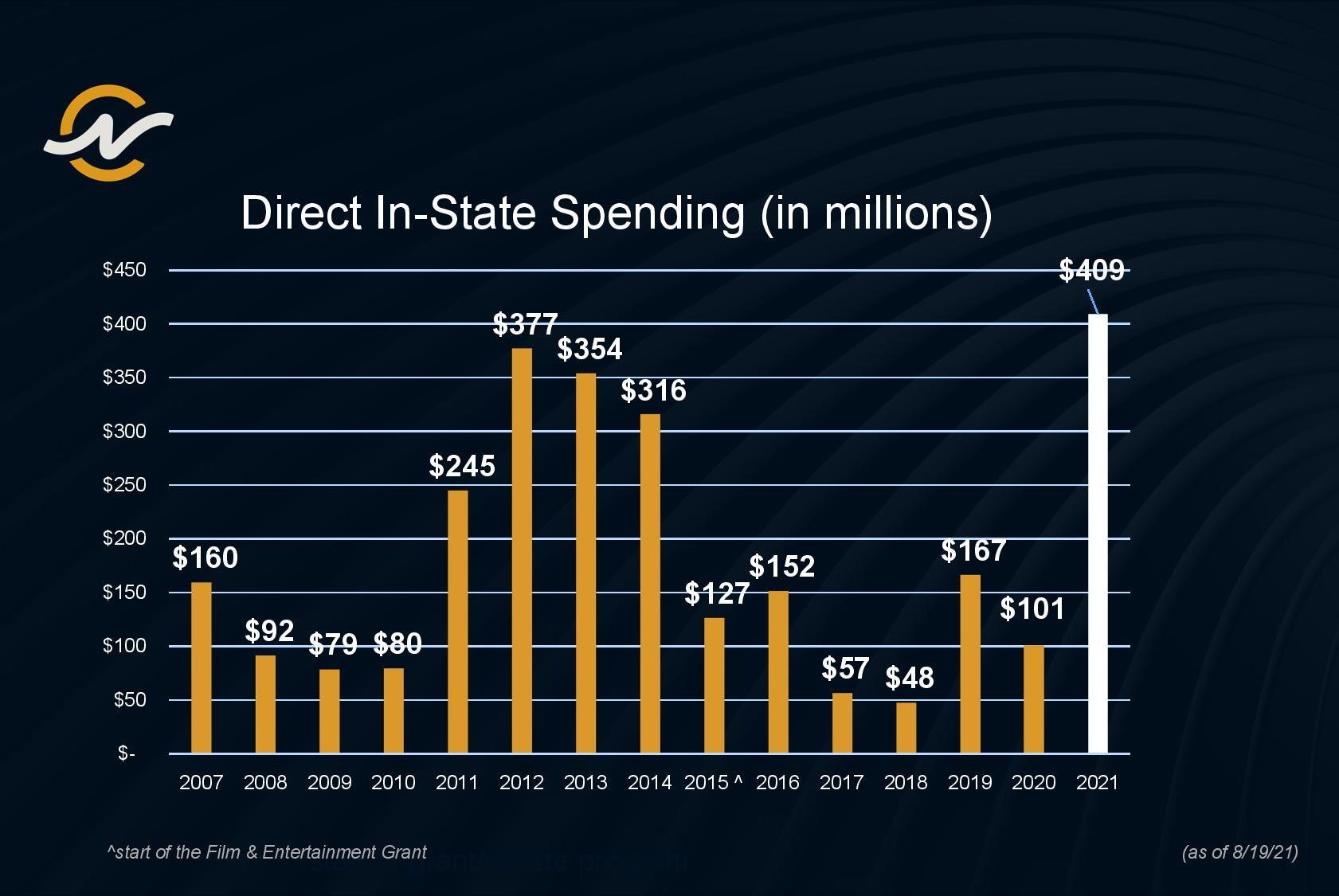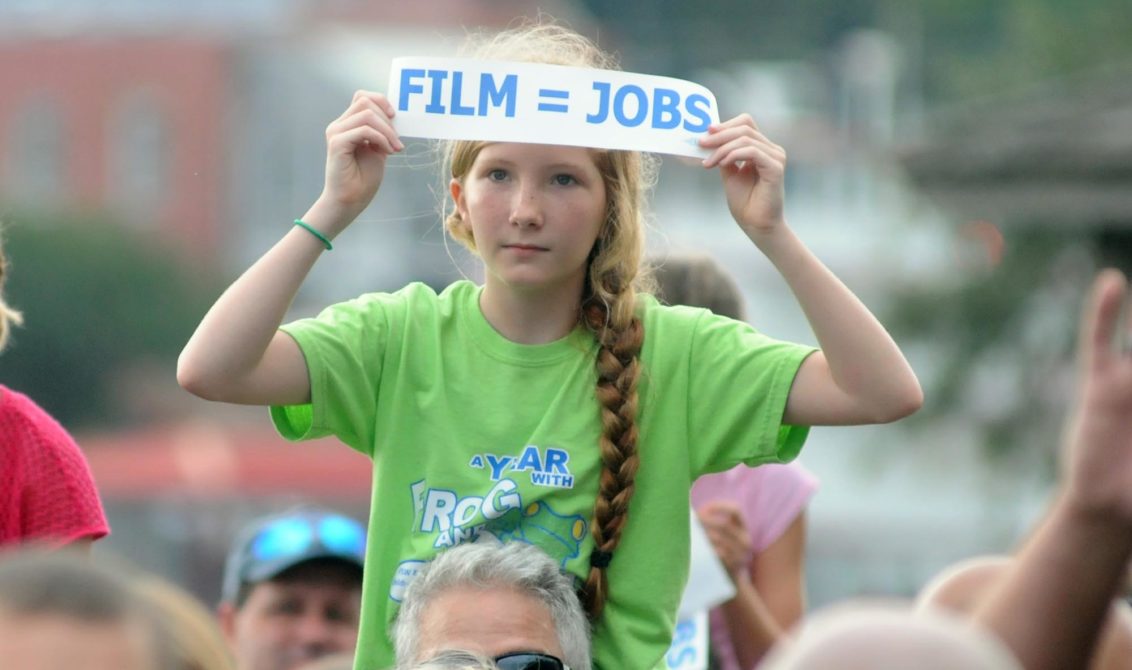December 7, 2021
Photo: Matt Born / AP (Elsa Monahan holds a sign during a group photo in support of the film industry in Wilmington in 2014.)
This year marked a tremendous win for North Carolina’s film industry, solidifying a promising future for upcoming projects, job opportunities, and economic activity. During a press conference at Wilmington’s EUE/Screen Gems Studios back in August, Governor Roy Cooper announced that current projects are on track to bring in a record-breaking $409 million to the state.
North Carolina has a long history of drawing in film productions since the North Carolina Film Office (originally the North Carolina Film Commission) creation in 1980, under Governor James B. Hunt. His appointee, Bill Arnold, spearheaded the organization to oversee and advance the state’s budding film industry. North Carolina became a hub for film activity due to its scenic versatility, favorable weather conditions, and Hollywood’s need for lower production costs. Famous productions such as The Color Purple, Dirty Dancing, Last of the Mohicans, Bull Durham, and Days of Thunder were all filmed in North Carolina throughout the ‘80s and ‘90s. This burgeoning demand also extended to television productions, which brought the WB’s critically acclaimed series, Dawson’s Creek, to Wilmington in the late ‘90s.

Naturally, Wilmington became a focal point of the state’s film industry, continuing to draw in more television and movie productions to the state into the early 2000s. Notable productions shot within the area include the popular series, One Tree Hill and the film, A Walk to Remember. However, productions stretched across the state, going as far as western North Carolina. The Biltmore Estate in Asheville was used in the 2001 film adaptation of Hannibal. The greater Charlotte area also became home to two renowned films during this time: Talladega Nights: The Ballad of Ricky Bobby filmed in Lake Norman and Charlotte Motor Speedway, and Shallow Hal filmed in Charlotte. The number of films and series shot during this time was a testament to North Carolina’s desirability as a filming location, even as international competition grew in the early 2000s.
North Carolina also faced domestic competition from Georgia, which drew production companies through its own state incentives. In efforts to keep up with Georgia’s growing film industry, North Carolina revisited and expanded upon its incentives in 2006, when Governor Mike Easley signed into legislation a full 15% tax credit on projects spending $250,000 minimum in-state (with a cap of $7.5 million).
The state’s popularity as a go-to film production destination only increased after 2010. Governor Bev Perdue was a champion for film incentives and further developed new legislation in 2009 to entice Hollywood to bring productions to the state. Senate Bill 943, which took effect in 2010, raised film tax credits to 25%. It also set hiring requirements for film companies, increasing in-state job opportunities. As a result, it drew in several big ticket movies and television productions such as The Conjuring (2012), The Hunger Games (2012), Iron Man 3 (2013), Sleepy Hollow (2013), and Under the Dome (2013). Governor Perdue’s new film incentives drove in-state spending, generating an increase from $80 million to $245 million within the first year of its creation.

The year Iron Man 3 was filmed in Wilmington (2012) brought in the most money through direct in-state spending, at $377 million prior to 2021. Several productions found homes in North Carolina that same year, including Homeland, Banshee, We’re The Millers, and Revolution. The subsequent two years came in over $300 million, highlighting the state’s attractive film industry. North Carolina also saw an influx of job opportunities directly related to the industry’s increased presence in the early 2010s, with the highest year creating more than 31,000 new opportunities in 2011. North Carolina was on its way to proving and establishing itself as a significant player within Hollywood film production.
The establishment of the North Carolina Film and Entertainment Grant in 2014 changed the game as its introduction issued a new era of incentives for production companies moving forward. The replacement program offered a rebate of up to 25% on qualified production expenses from a $10 million grant (increased to $30 million in 2015 and $31 million in 2017). The shift away from the prior tax credit program took effect in January 2015 because North Carolina’s Republican-controlled legislature wanted to cease most incentive funding in favor of lower corporate income taxes.

Debate over the future of the state’s film industry followed. Some officials and legislators were not confident the grant program would be competitive enough to compete with other states’ film incentives. The program had a rough transition period, with in-state spending dropping to $127 million and offering a total of 3,667 job opportunities in 2015. The industry took a nosedive as North Carolina struggled to reel in productions. The subsequent years, 2017 and 2018, had record lows, with in-state spending at $57 million and $48 million, respectively. Some attribute North Carolina’s production drought to the repeal of HB2 in 2016. However, confusion over the new incentives, worker availability, and caps on the grant’s fund size– which limited major production involvement and geographically narrowed production locations— all contributed to the loss of prospective projects. The state’s film industry has been working to rebuild since 2018 by targeting specific markets and increasing the grant size to allow for more projects. Their efforts paid off as 2019 showed promise of a recovering industry with $167 million in spending– the highest amount since 2013. And the pandemic aside, that momentum has carried into 2021.

“The surge in activity and film production in the Wilmington region has been building for quite some time, and it’s a testament to the many advantages we offer filmmakers,” said Bill Saffo, Mayor of Wilmington and Chair of the Wilmington Regional Film Commission. “[This] milestone marks good news for our economy. More people are working, and producers are buying a lot of material here, turning to local vendors to bring these films to life.”
The staggering $409 million investment this year marks a rejuvenation within the state’s film industry that hasn’t been seen since the early 2010s. North Carolina has finally worked out the kinks in the incentives program and rebuilt its film industry using a different model than its competitors. The future looks bright and filled with more opportunity.
“These multimillion-dollar revenues for 2021 are great economic development wins for North Carolina,” said North Carolina Commerce Secretary Machelle Baker Sanders. “Our film industry, with its experienced production talent and compelling film locations, creates good-paying jobs and positive economic impacts for our economy.”
Additionally, job opportunities have soared, reaching its highest amount since the creation since 2013, according to the North Carolina Travel and Tourism Board. This includes 1,100 talent opportunities, 19,000 extra opportunities, and over 4,800 crew hires, and none of these numbers include “drop-in” projects such as travel television shows. Outside of film industry jobs, the demand for local businesses, hospitality, and restaurant opportunities contribute to further positive economic impact for the state.
There are 89 projects set to be filmed within North Carolina this year across all eight prosperity zones, with 18 approved for the North Carolina Film and Entertainment Grant. A recipient of the grant, FOX’s Our Kind of People starring Yaya DaCosta and Morris Chestnut, has been well-received on social media after a clip from the second episode went viral on Twitter. Other grant recipients include Florida Man and the latest film in the Halloween franchise, Halloween Kills. Movies set to hit the screen include Christmas in Harmony, a Hallmark original; the highly anticipated supernatural horror film The Black Phone; and Scream 5, the relaunch of the cult classic franchise.

“Our consistent message of a strong workforce coupled with a stable and reliable rebate program has been heard loud and clear by production executives and has resulted in these economic developments wins for North Carolina,” said Guy Gaster, director of the North Carolina Film Office; the organization is housed within the Economic Development Partnership of North Carolina and leads the state’s recruiting efforts with N.C. Department of Commerce. “There is a high demand for content, and our state is proving that we are among the best in helping to bring these stories to life on screens of all sizes.”
The future of North Carolina’s film industry looks auspicious as projects continue to roll in, but maintaining interest is key. Incentives play a crucial role in acquiring interest to create long-term film endeavors. Gaster says a healthy grant program should remain a top priority in our future: “The state [should] continue to have a reliable program that production companies understand is stable and readily available. We [should] also work to continue to grow and improve our workforce and infrastructure– but a stable incentive remains the top recruitment tool.”
Governor Roy Cooper recently signed into law a new state budget that will loosen the financial qualifications film projects must meet to receive incentives. It will also increase the amount television shows can receive in rebate for a single season of production. All positive news for the film industry in North Carolina after a record-breaking year in in-state film spending.
Read next:

 By
By 
